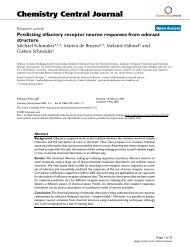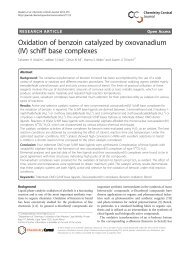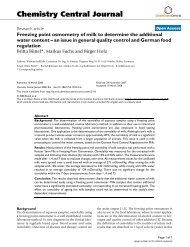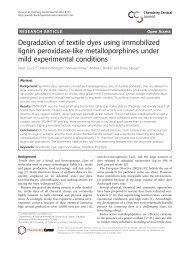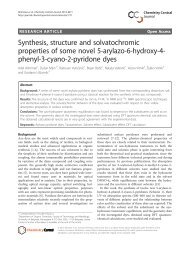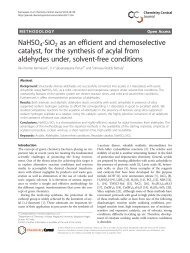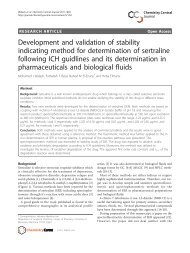Quinazoline derivatives: synthesis and bioactivities - Chemistry ...
Quinazoline derivatives: synthesis and bioactivities - Chemistry ...
Quinazoline derivatives: synthesis and bioactivities - Chemistry ...
Create successful ePaper yourself
Turn your PDF publications into a flip-book with our unique Google optimized e-Paper software.
Wang <strong>and</strong> Gao <strong>Chemistry</strong> Central Journal 2013, 7:95 Page 9 of 15<br />
http://journal.chemistrycentral.com/content/7/1/95<br />
N<br />
O<br />
F 3 CO<br />
O<br />
O<br />
N<br />
H<br />
75<br />
N<br />
N<br />
N<br />
O<br />
O<br />
O<br />
O<br />
HN<br />
N<br />
N<br />
76<br />
O<br />
N<br />
N<br />
N<br />
H<br />
N<br />
N<br />
R<br />
77 R=NO 2 78 R=Cl<br />
79 R=Br 80 R=O i Pr<br />
Figure 2 Structures of representative 4-substituted quinazolines with bioactivity.<br />
O N H<br />
N<br />
N<br />
81<br />
O<br />
O<br />
indicated that substituent of ethynyl at meta-position<br />
or halogen on the 7-anilino were desirable for high potency.<br />
And among the products, compound 76 (Figure 2)<br />
expressed high resistance for EGFR <strong>and</strong> potent selectivity<br />
for kinases Abl <strong>and</strong> Arg, <strong>and</strong> showed good pharmacokinetic<br />
properties in preclinical evaluation. Moreover, it<br />
inhibited the growth of many human solid tumor xenografts<br />
in a dose-dependent way(range 50–100 mg/kg).<br />
Acrolein amine quinazolines substituted on the 6-<br />
position could irreversibly bind with intracellular ATP<br />
binding domain of EGFR [70,71]. 6-Substituted-4-anilino<br />
quinazolines with irreversible binding property with EGFR<br />
were synthesized by Vasdev et al., starting from [ 18 F]<br />
fluoroanilines [3].<br />
There are some other researches aiming at replacing<br />
4-anilino with other substituents [72-74], such as<br />
thiosemicarbazide, which possesses a variety of biological<br />
profiles, including anti-cancer, anti-fungi, anti-bacterial,<br />
anti-inflammation <strong>and</strong> anti-virus. Thus it acts as an efficient<br />
pharmacophore in drug design. In order to find<br />
novel quinazoline compounds with same enzyme sites<br />
as 4-anilinoquinazoline, a series of 4-thiosemicarbazide<br />
quinazolines were synthesized by He et al.[75], <strong>and</strong> their<br />
anti-cancer activities were estimated using 5 human<br />
cancer cell lines with 5-FU as reference. Preliminary<br />
results showed that some produced compounds exhibited<br />
better inhibitory activity against these 5 human cancer<br />
cell lines than 5-FU. Structure-activity relationship results<br />
indicated that compounds with unsubstituted<br />
quinazoline ring <strong>and</strong> benzene ring or chloro/fluoro<br />
substituted benzene ring were proved to have higher<br />
anti-cancer activity.<br />
Platelet-derived growth factor receptor phosphorylation<br />
inhibitors<br />
Cell proliferation induced by unusual platelet-derived<br />
growth factor receptor (PDGFR) will lead to a variety of<br />
proliferative diseases such as atherosclerosis, restenosis<br />
following PTCA, glomerulonephritis, glomerulosclerosis,<br />
liver cirrhosis, pulmonary fibrosis, <strong>and</strong> cancer [76-86].<br />
PDGFR phosphorylation inhibitors are potential treatments<br />
for these proliferative diseases [87].<br />
Matsuno et al. obtained a series of compounds<br />
containing 4-piperazinyl substituted quinazoline core<br />
from screening of PDGFR phosphorylation inhibitors<br />
[87]. KN1022 was adopted as the prototype inhibitor<br />
in structure-activity relationship analysis, <strong>and</strong> the 4-<br />
nitrobenzene urea moiety was studied, which indicated<br />
that compounds with substitution on 4-position of<br />
benzene ring worked best, but activity would be reduced<br />
with more than two substituents on benzene<br />
ring. In their research, several KN1022 (77) (Figure 2)<br />
<strong>derivatives</strong> with favorable activity were obtained, including<br />
4-(4-methylphenoxy)phenyl,4-tert-butylphenyl <strong>and</strong> 4-<br />
phenoxyphenyl. In vivo assays were conducted by oral<br />
administration of these three compounds (30 mg/kg, twice<br />
daily) to SD rats. 4-chlorophenyl (78), 4-bromophenyl<br />
(79), <strong>and</strong> 4-isopropoxyphenyl (80) (Figure 2) analogues<br />
were then proved to have obvious inhibitory activity<br />
against neointima formation in the carotid artery of the<br />
balloon catheter de-endothelialized vessel in the rats.<br />
Germicide<br />
Li et al. synthesized <strong>and</strong> biologically evaluated a series<br />
of 4-quinazoline oxime ether compounds in purpose of





